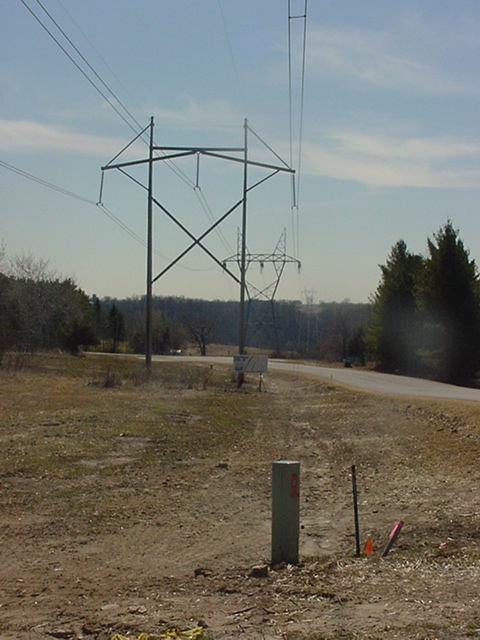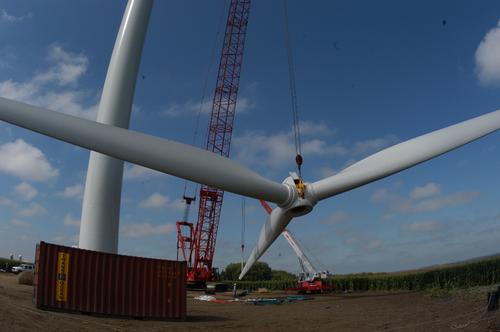Routing Alternate Review — Environmental Assessment isn’t enough
September 23rd, 2015
 Transmission over Red Wing’s Westwood subdivision
Transmission over Red Wing’s Westwood subdivision
In routing permitting using “Alternate Review” and in wind siting permitting under Minn. Stat. Chapter 216F, exempted from environmental review, the environmental review is inadequate. An Environmental Impact Statement is necessary! DOH!
Looking at Minnesota’s draft Rules for Transmission/Utility Infrastructure siting and routing, it’s clear that the recent Minnesota Court of Appeals decision remanding the Sandpiper pipeline case to the Public Utilities Commission has implications beyond Certificate of Need.
The Court’s bottom line was:
This was based on its holding that a Certificate of Need decision by the Public Utilities Commission was a “major governmental action.”
Just as a Certificate of Need is a major governmental decision, a Siting Permit or a Routing Permit is a major governmental decision. The Minnesota statute and rules provide for “Alternate Review” for siting and routing:
And in this statute, there’s a subdivision authorizing an “environmental assessment.”
Subd. 5.Environmental review.
Throughout this rulemaking, a number of us participating have been stressing that this “environmental assessment” does not comply with MEPA. Under the logic of the “Sandpiper” decision – OPa150016-091415, the Court would agree.
Yet here are the draft rules for Siting and Routing — search for “environmental assessment” in the draft:
And Certificate of Need draft rules:
And regarding wind permits, also a major governmental decision, these are statutorily exempted from environmental review by exempting it from PPSA – Minn. Stat. 216E.03, Subd. 5 “Environmental Review.”
216F.02 EXEMPTIONS.
(a) The requirements of chapter 216E do not apply to the siting of LWECS, except for sections 216E.01; 216E.03, subdivision 7; 216E.08; 216E.11; 216E.12; 216E.14; 216E.15; 216E.17; and 216E.18, subdivision 3, which do apply.
Wind siting permits are exempt from environmental review? Public Utilities Commission issuance of wind project siting permits is a major governmental action. Nope, not compliant with MEPA.
The rulemaking process — nothing changes…
September 13th, 2015
Many thanks to the “little birdie” who brought this decades old report to my attention:
Yes, this is a report from the Minnesota Legislative Auditor from 1993, and if you read it, you’ll see little has changed is so many years… The issues raised are issues we’ve been raising in the Public Utilities Commission rulemaking for Minn. R. Ch. 7849 and 7850 (Certificate of Need and Siting/Routing). AAAAAAAAAAAACK!
For example, from the Summary:
For example, in the PUC Rulemaking for 7849 and 7850 (PUC Docket 12-1246), it’s been an over two-year-long process, and few are showing up anymore. We weigh in, some things are taken into account in the drafts, and then that disappears from the next draft. How can it feel like anything but a colossal waste of time? Yet if we weren’t there, the utilities would get everything they want. And as with the utility Certificate of Need and Siting/Routing processes, rulemaking has the same notice and public participation problems. It’s all the same, deja vu all over again.
… and also from the report …
Does this sound familiar?
So what is the bottom line of this report?
Also, we recommend the following additional changes to the Administrative Procedure Act:
… and …
In addition to changing the APA and other statutes that govern agency rulemaking, we recommend that:
Now what’s Micheletti up to?
April 21st, 2015
Doesn’t this guy ever quit? New legislation with new option, wanting to change the law to allow a “biomass” plant on the Mesaba Project site. WHAT? Aren’t they paying attention to the Laurentian Energy Authority’s unworkable “biomass” projects in Hibbing and Virginia, the “biomass” plants that don’t have enough feedstock and so are burning coal? Did they forget that the MPCA has only issued one woody biomass permit, for Laurentian (Hibbing and Virginia) and that that permit was violated, so extremely that the MPCA issued fines and reworked the permit?
LEGALECTRIC POST: Laurentian “biomass” Air Permit Draft (second time around)
LEGALECTRIC POST: “Biomass” violates air permit – fines likely
DOH!
Thanks to a little birdie for the heads up on this.
Here’s the change, hidden in Senate File 2101:
 Today, say NO to lines 191.4 – 191.19 of Senate File 2101.
Today, say NO to lines 191.4 – 191.19 of Senate File 2101.
Minnesota’s nuclear moratorium — gone?!?!?!
May 8th, 2010
I read with horror news of Rep. Bill Hilty’s amendment eliminating the moratorium on new nuclear generating plants that passed in a House Ominous Bill this week. WHAT ARE THESE YAHOOS THINKING? The Senate already approved it, and now the House… and I just can’t see Pawlenty doing anything but signing it with glee.
(sudden feeling of ice picks going through temples… buried in brain… electricity applied…)
AAAAAAAAGH!
Is this the “price” of the rollback of exemptions of utilities from eminent domain laws? Is it an attempt to look like they’re repealing it when “conditions” mean it won’t happen? (like those that said Obama really doesn’t mean what he’s saying about coal gasification or transmission, he knows better) Is it more of the same deal-making that took the Renewable Development Fund away from PrairIe Island Indian Community, or the enviro sell-outs that gave us the 2005 Transmission bill? Minnesota’s second nuclear waste storage facility at Monticello, now two piles piling with no plan in sight, PERMANENT?
What I’m hearing about this from various little birdies….
… is NOT encouraging — ooooohhhhhhh do I have a headache…
… apparently NO ONE OBJECTED!
NO ONE OBJECTED?!?!?!?!
AAAAAAAAGH!
Here’s the bill as it is on the Senate site:
Here’s how Rep. Bill Hilty, Chair of House Energy, amended it:
Page 4, after line 11, insert:
“Sec. 4. [216B.1695] NUCLEAR POWER PLANT; COST RECOVERY.
(a) The commission may not allow any of the following costs attributable to the construction of a nuclear generating plant begun after July 1, 2010, to be recovered from Minnesota ratepayers until the plant begins operating at a monthly load capacity factor of at least 85 percent:
(1) planning, design, safety, environmental, or engineering studies undertaken prior to construction; or
(2) the costs of obtaining regulatory approval, including permits, licenses and any other approval required prior to construction from federal, state and local authorities.
(b) The commission may not allow any of the following costs attributable to the construction of a nuclear generating plant begun after July 1, 2010, to be recovered from Minnesota ratepayers:
Journal of the House – 98th Day – Thursday, May 6, 2010 – Top of Page 11584
(1) any construction costs exceeding the projected construction cost of the generating plant and any ancillary facility constructed by the utility to temporarily or permanently store nuclear waste generated by the plant, as identified in the utility’s certificate of need application submitted under section 216B.243;
(2) the costs of insuring the plant against accidents that exceed the cost of insurance for a fossil fuel plant of equivalent capacity; or
(3) contributions from the plant to provide and maintain local fire protection and emergency services to the plant in case of an accident.
(c) Except for regulatory costs of state agencies, no revenues from taxes or fees imposed by the state of Minnesota may be used to pay for any portion of the preconstruction, construction, maintenance, or operating costs of a nuclear generating plant, or to assume any financial risk associated with an accidental release of radioactivity from the generating plant or an ancillary facility constructed by the utility that owns the generating plant to temporarily or permanently store nuclear waste generated by the plant.
Sec. 5. Minnesota Statutes 2008, section 216B.243, subdivision 3b, is amended to read:
Subd. 3b. Nuclear power plant; new construction prohibited; relicensing. (a) The commission may not issue a certificate of need for the construction of a new nuclear-powered electric generating plant provided that the certificate of need application contains a separate estimate of preconstruction and construction costs that does not include any of the costs identified in section 216B.1695, paragraphs (a) and (b).
(b) Any certificate of need for additional storage of spent nuclear fuel for a facility seeking a license extension shall address the impacts of continued operations over the period for which approval is sought.”
Renumber the sections in sequence and correct the internal references
Amend the title accordingly.
Way below is the list of yeas and nays, do send each of them a missive:
The ones who voted against it are the strangest set of bedfellows! But KUDOS TO THEM!
If you click on this to look at the whole back and forth with amendments, scroll to p. 11579 to start. Here’s the vote:
The bill was read for the third time, as amended, and placed upon its final passage.
Those who voted in the affirmative were:
Those who voted in the negative were:









